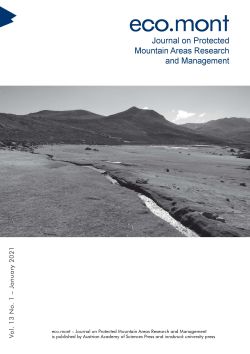Valerie Braun – Martin Coy – Günter Köck (Eds.)
eco.mont
Journal on Protected Mountain Areas Research and Management
Joanna Hibner,
Jarosław Balon,
Miłosz Jodłowski,
Szymon Ciapała
S. 41 - 54
doi:
10.1553/eco.mont-13-1s41
Verlag der Österreichischen Akademie der Wissenschaften
doi:
10.1553/eco.mont-13-1s41
Abstract:
Mountain areas are particularly attractive for the development of winter activities such as skiing, owing to both morphological and climatic conditions. However, mountain areas are at the same time vulnerable. For this reason, they are often under protection. This study focuses on two important and heavily used ski resorts in the Tatra National Parks, Kasprowy Wierch (Poland) and Skalnaté Pleso (Slovakia), looking at skiers’ opinions and complaints regarding the resorts. In addition, a comparison between the resorts was conducted. In order to verify the relationship between socio-demographic variables and the skiers’ opinions, two types of statistical tests were used: Spearman’s rank correlation coefficient and Chi-square. The results show that the Kasprowy Wierch ski resort received a larger number of negative comments than Skalnate Pleso. However, Skalnate Pleso drew more negative opinions regarding the impact of the cable car and ski area on the landscape. The consequences of fulfilling visitors’ expectations can be used practically by the managers of the protected areas.
protected areas, ski resorts, Tatra Mountains
Published Online:
2020/12/30 09:48:01
Object Identifier:
0xc1aa5576 0x003c2116
Rights:https://creativecommons.org/licenses/by-nc-nd/4.0/
The journal “eco.mont” – Journal of protected mountain areas research and management – was published for the first time in June 2009.
The journal was founded as a joint initiative of the Alpine Network of Protected Areas (ALPARC), the International Scientific Committee on Research in the Alps (ISCAR), the Austrian Academy of Sciences (ÖAW) and the University of Innsbruck.
The journal aims to highlight research on and management issues in protected areas in the Alps without excluding other protected mountain areas in Europe or overseas. Its target audiences are scientists from all related disciplines, managers of protected areas and interested individuals including practitioners, visitors, teachers, etc.
The journal presents peer-reviewed articles in English by authors who research protected mountain areas and management issues within these areas. It's published twice a year as a collaboration of the Austrian Academy of Sciences Press – responsible for the e-version – and Innsbruck University Press – responsible for the print version.
Die Zeitschrift „eco.mont“ – Zeitschrift zur Forschung in Gebirgsschutzgebieten – erschien im Juni 2009 zum ersten Mal. Die Zeitschrift wurde auf Initiative des Netzwerks Alpiner Schutzgebiete (ALPARC), der Schweizer Akademie der Naturwissenschaften (ISCAR), der Österreichischen Akademie der Wissenschaften (ÖAW) und der Universität Innsbruck gegründet. Sie hat das Ziel, Themen zu behandeln, die gleichzeitig Forschung und Verwaltung in und über die Schutzgebiete der Alpen betreffen, ohne dabei andere Gebirgsschutzgebiete Europas oder anderswo auszuschließen. Diese neue Zeitschrift richtet sich an ein Publikum von Wissenschaftlern der verschiedensten Fachbereiche, an die Verwalter von Schutzgebieten und an alle sonstigen Interessierten, Praktiker, Besucher, Lehrpersonal etc. einbegriffen. Die Zeitschrift veröffentlicht begutachtete Beiträge auf Englisch von Autoren, die Fragen der Gebirgsschutzgebiete und deren Verwaltung betreffen. Sie erscheint zweimal pro Jahr, auf der Basis der gemeinsamen Anstrengungen des Verlags der Österreichischen Akademie der Wissenschaften, der für die digitale Fassung verantwortlich ist, und der Presse der Universität Innsbruck, verantwortlich für die gedruckte Fassung.



 Home
Home Print
Print
 References
References
 Share
Share

